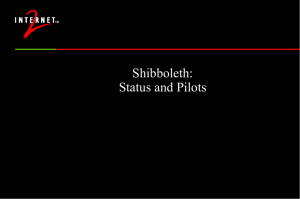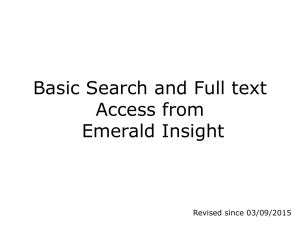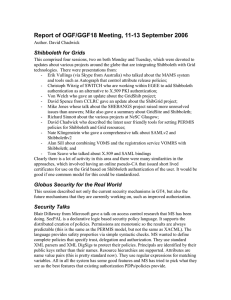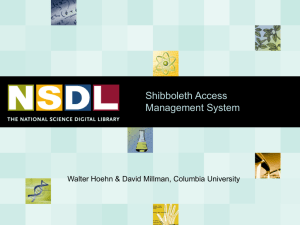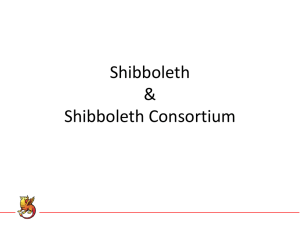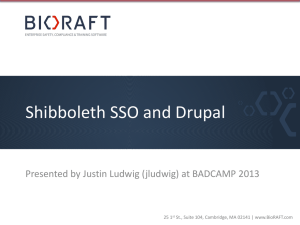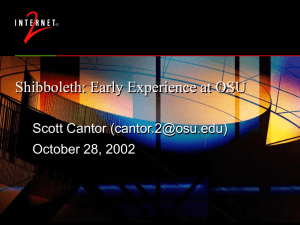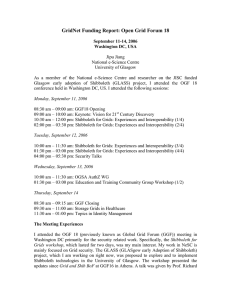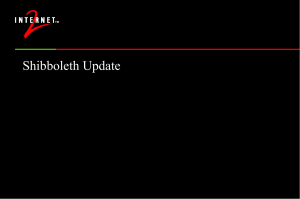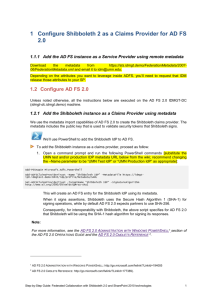slides - Terena TNC 2003
advertisement
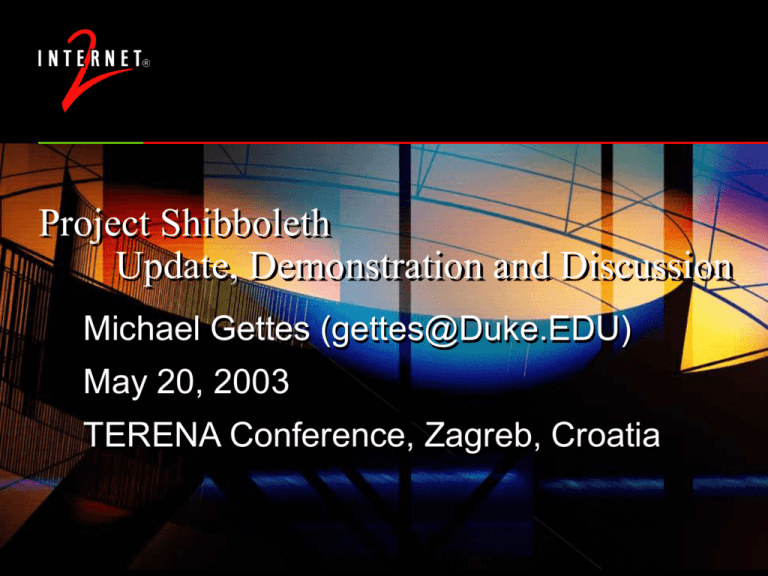
Project Shibboleth Update, Demonstration and Discussion Michael Gettes (gettes@Duke.EDU) May 20, 2003 TERENA Conference, Zagreb, Croatia Shibboleth A word which was made the criterion by which to distinguish the Ephraimites from the Gileadites. The Ephraimites, not being able to pronounce sh, called the word sibboleth. See -Judges xii. Hence, the criterion, test, or watchword of a party; a party cry or pet phrase. - Webster's Revised Unabridged Dictionary (1913): 2 Stage 1 - Addressing Three Scenario’s Member of campus community accessing licensed resource • Anonymity required Member of a course accessing remotely controlled resource • Anonymity required Member of a workgroup accessing controlled resources • Controlled by unique identifiers (e.g. name) Taken individually, each of these situations can be solved in a variety of straightforward ways. Taken together, they present the challenge of meeting the user's reasonable expectations for protection of their personal privacy. 3 Establishing a User Context 4 Getting Attributes and Determining Access 5 Shibboleth Architecture 6 Shibboleth Architecture -Managing Trust TRUST Attribute Server Browser Origin Site Shib engine Target Web Server Target Site 7 Milestones Project formation - Feb 2000 Stone Soup Process - began late summer 2000 with bi-weekly calls to develop scenario, requirements and architecture. Linkages to SAML established Dec 2000 Architecture and protocol completion - Aug 2001 Design - Oct 2001 Coding began - Nov 2001 Alpha-1 release – April 24, 2002 OpenSAML release – July 15, 2002 v0.7 Shibboleth released Nov 25, 2002 v0.8 March 1, 2003 v1.0 May 2003 (end of month) v1.1 conversations ruminating; v1.2 may be the plateau 8 Code status v0.8 released March 2003 (coding teams – MIT, Columbia, Ohio State, CMU); v1.0 due out April 10 v0.7 much easier to install than alpha’s. C/C++ only on origin. Java still on target. Relatively safe to deploy and experiment Release issues – platform dependencies, fragile Apache components, binaries vs source, etc… v0.7 to v0.8 new features – ARP’s redone, added robustness timeframes – march 1, 2003 general release V0.8 to 1.0 – SAML 1.1 support, bug fixes and re-packaging 9 Course Management Early Adopters WebCT Webassign Blackboard (Demonstrated April, 2003) OKI 10 The Library Pilots •Explore and Evaluate the utility of the Shibboleth model (attributes) for controlling access to licensed resources •Identify problems and issues with this approach • How well do existing licenses map to attributes? • Library “walk-in” customers •Identify and address Shib deploy issues for campuses AND for vendors •Explore new possibilities, including role-based access controls 11 Campus Participants Carnegie Mellon Penn State Columbia U. Colorado Dartmouth U. Michigan Georgetown U. Washington London School of Economics U. Wisconsin - Madison New York Unv. UCOP (U. California System) Ohio State U.Texas Health Science Center at Houston Others coming on 12 Vendor Participants EBSCO ~ Elsevier OCLC Sfx (Ex libris) JSTOR McGraw Hill eBooks Innovative (III) Consortial efforts: WRLC, Athens, … 13 Shibboleth Deployment Issues Access Issues Kiosks and walk-ins logins for on-campus use Licensing issues reconciling license structures with directory structures system and consortial issues mitigating disintermediation Functional issues handling Shibbed and non-Shibbed resources roll-out strategies entitlements vs attributes what attributes to pass how to structure the attribute name space 14 A Quick Demonstration Shib Demo Site 15 Next steps Convergence with other efforts (PAPI, Permis, A-Select, etc) Shibboleth used as a WebISO solution, the N-Tier problem What is a Federation? How do we define it? Sub-Fed, Fed Clusters, Super Federations Shibboleth the architecture vs Shibboleth the web service Shibboleth the technology vs Club Shib the trust model Federated Digital Rights Management Federated P2P Privacy Management Systems – see http://www.ischool.washington.edu/shibbui/index.html Personal Information Managers – see http://www.brown.edu/cgibin/httool.epl 16 Personal Resource Manager 17 Privacy Management Systems 18 Overall Trust Fabric 19
